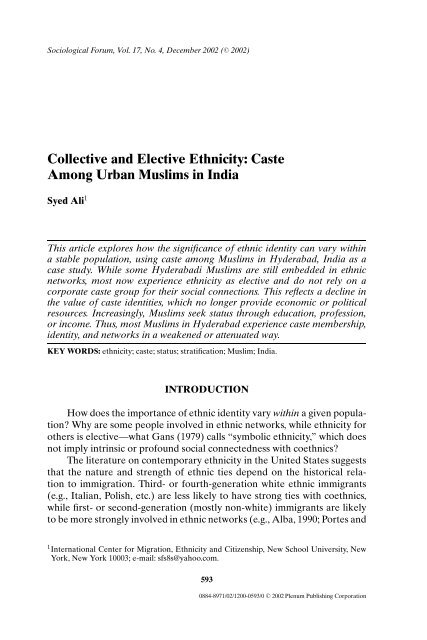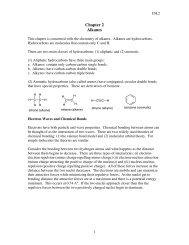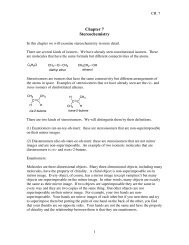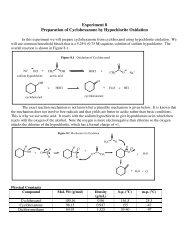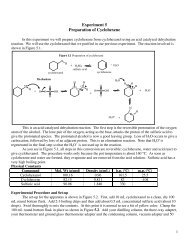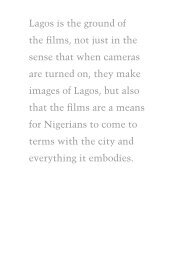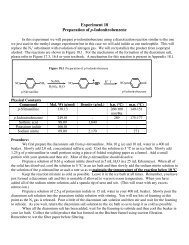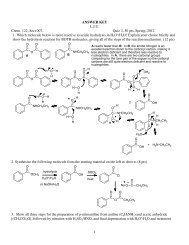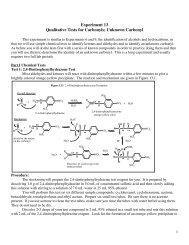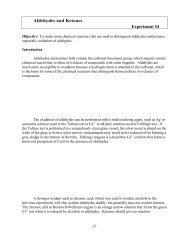Collective and Elective Ethnicity: Caste Among Urban ... - myweb
Collective and Elective Ethnicity: Caste Among Urban ... - myweb
Collective and Elective Ethnicity: Caste Among Urban ... - myweb
You also want an ePaper? Increase the reach of your titles
YUMPU automatically turns print PDFs into web optimized ePapers that Google loves.
<strong>Collective</strong> <strong>and</strong> <strong>Elective</strong> <strong>Ethnicity</strong>: <strong>Caste</strong> <strong>Among</strong> <strong>Urban</strong> Muslims in India 597districts of Hyderabad state were merged with the Telugu-speaking districtsof the former Madras presidency to form the state of Andhra Pradesh, ofwhich Hyderabad city was made the capital.Since 1948, Muslims have experienced drastic downward social mobilityas a result of the displacement of the regime of the Nizam. Many Muslims,who were educated only in Urdu or Persian, lost their positions in governmentservice, as they were not functional in the new official state languageof Telugu or the national languages of Hindi <strong>and</strong> English. 4 Many who hadbeen employed by the Nizam or his nobles in service positions found themselvesdisplaced. A survey of rickshaw drivers in Hyderabad city in 1961found that 28% of Muslim drivers were former employees of the Nizam’sEstates (Indian Institute of Economics, 1962:14–15). Another survey foundthat 48% of beggars in Hyderabad were Muslim, many of whom had beenemployed in the service of the Nizam or his subordinates as regular or irregulararmed forces (Alam, 1995; Indian Institute of Economics, 1956; Khan,1971). More recently, though, there has been much upward mobility, in partas a result of remittances from family members in the Persian Gulf states <strong>and</strong>the West (Javed, 1990; Naidu, 1990). Such remittances have deeply affectedsocial relations in Hyderabad, as in other places in South Asia <strong>and</strong> elsewhere(Kurien, 1993; Lefebvre, 1999; Levitt, 1998).Muslims have a significant numerical presence in Hyderabad, accountingfor 39% of the population of 3.1 million people, while in Andhra Pradeshthe overall population of Muslims is only 9% (see http://www.<strong>and</strong>hrapradesh.com, the official website of the government of Andhra Pradesh, Table 1.21).Hyderabad has one of the largest concentrations of Muslims in an urbanarea of India. Nationwide the percentage of Muslims is 12% (or 101 millionof nearly 840 million; see http://www.censusindia.net/cendat/datatable23.html). 5 Further, Muslims account for more than half the population in theOld City, the center of Hyderabadi Muslim culture. 6 This large concentrationof Muslims <strong>and</strong> the long history of Muslim rule have led to the4 The Indian constitution recognizes 18 languages, including English. Each state has its ownofficial language(s), <strong>and</strong> conducts its affairs in those languages. Hindi is the official nationallanguage, <strong>and</strong> English is the “link language,” the language that elites throughout India use tocommunicate.5 The numbers in both these web sites are taken from the 1991 census. Provisional data fromthe 2001 census are beginning to be tabulated. The population is given as 1,027,000,000persons, but no breakdown by religion is yet available. See http://www.censusindia.net/results/resultsmain.html. If the proportion of Muslims remains at 12%, the Muslim populationof India will be 124 million persons.6 Like many cities in South Asia, Hyderabad is divided into an old, walled city, <strong>and</strong> a new city.The new city became more important during the 1930s when the Nizam moved from the OldCity to a new city area. The Nizam’s nobles followed him, as did much productive economicactivity. The Old City then became an economic shell of its former self, a slum. See Naidu(1990) for a description of the decay of the Old City. Little of the wall remains st<strong>and</strong>ing today.
598 Alidevelopment of a unique Hindu–Muslim syncretic culture in Hyderabad,at least at the elite level (Leonard, 1973). Today, however, this syncreticculture in Hyderabad has all but disappeared. Hindus <strong>and</strong> Muslims havebecome socially <strong>and</strong> economically estranged, as Hyderabad has become oneof the cities in India most prone to communal (i.e., Hindu–Muslim) violence(see Kakar, 1996; Varshney, 1997).Before discussing Muslim caste relations in Hyderabad, I must describethe theoretical relationship between caste <strong>and</strong> ethnicity, what I mean byMuslim caste, <strong>and</strong> its relationship to Hindu caste.CASTE AND ETHNICITY AS STATUS FORMATIONS 7Classical Hindu texts divide the Hindu population into four rankedcategories called varnas: the Brahmins, or priests; Kshatriyas, the warriors<strong>and</strong> kings; Vaishyas, the farmers <strong>and</strong> merchants; <strong>and</strong> the Sudras, the laborers<strong>and</strong> servants to the three higher caste categories. Below the Sudras is afifth category, ati-Sudras—today known as untouchables, Harijans,orDalits,as many political activists have taken to calling themselves. Dalits are notactually one caste, but a category that includes many hierarchically arrangedcastes, all of which are considered by upper castes to be ritually polluted, oruntouchable.While varna denotes the ideal-type category, people are grouped interms of actual membership into many discrete castes called jatis. Jatis numberin the thous<strong>and</strong>s across India. Some are localized, occurring in only onevillage, while other jatis are found throughout India. These are further subdividedinto (generally endogamous) marriage circles. The caste system isactually thous<strong>and</strong>s of caste systems that vary village by village across thesubcontinent. However, all these local caste systems represent closed, selfreferencing,hierarchical stratification schemes.7 The literature on Hindu caste is vast, <strong>and</strong> beyond the scope of this paper (e.g., Dirks, 1987;Dumont, 1980; Raheja, 1988). Marriott (1976, 1989; see also Marriott <strong>and</strong> Inden, 1977) arguesfor interpreting Indian culture through indigenous sociological categories, while Milner (1994)employs a Weberian analysis to examine caste as the most extreme form of status stratification.Unlike Marriott, Milner sees caste as comparable to status systems elsewhere. While there arearguments over how best to underst<strong>and</strong> the caste system, another question has been over justhow rigid this system historically has been. Cohn (1987) argues that the caste system(s) werequite fluid <strong>and</strong> that hierarchies of caste were contingent upon local conditions of rule. Thischanged under the British, who established thorough <strong>and</strong> relatively stable control, directly<strong>and</strong> indirectly, over all of India. Also, through the British-administered census, caste wasenumerated for the first time, <strong>and</strong> codified according to a Brahmanical view. Thus, in manyplaces where caste was contested, a hierarchy of castes with Brahmins as superior was imposedby the British (Dirks, 1987). For the most thorough discussion of caste, see Bayly (1999), whogives an excellent account of the development <strong>and</strong> changes in caste throughout India from theancient Vedic period to the present.
<strong>Collective</strong> <strong>and</strong> <strong>Elective</strong> <strong>Ethnicity</strong>: <strong>Caste</strong> <strong>Among</strong> <strong>Urban</strong> Muslims in India 599<strong>Caste</strong> groups take active steps to maintain or improve their positions inthe caste hierarchy relative to other groups. They do this mainly by conformingto social norms specific to each caste group (their dharma), by showingconcerns for purity <strong>and</strong> pollution, <strong>and</strong> through the regulation of associationswith others, especially of marriage <strong>and</strong> eating (Milner, 1994:58–61).Weber sees caste as the extreme form of ethnicity, <strong>and</strong> both caste <strong>and</strong>ethnicity as types of status formations:A status segregation grown into a caste differs in its structure from a mere ethnicsegregation: the caste structure transforms the horizontal <strong>and</strong> unconnected coexistencesof ethnically segregated groups into a vertical social system of super- <strong>and</strong>subordination. ...Ethnic coexistence, based on mutual repulsion <strong>and</strong> disdain, allowseach ethnic community to consider its own honor as the highest one; the caste structurebrings about a social subordination <strong>and</strong> an acknowledgement of “more honor”in favor of the privileged caste <strong>and</strong> status groups. (Weber, 1968:934)Both ranked caste <strong>and</strong> unranked ethnic groups, then, are types of statusformations, <strong>and</strong> lie on a continuum; their only theoretical difference is oneof domination. But the structure of caste stratification <strong>and</strong> domination isgiving way in India to other types of status definition, class concerns, <strong>and</strong> theleveling effects of politics in the postcolonial, democratic era.Due largely to processes of political competition in the arena of parliamentarypolitics <strong>and</strong> to the effects of economic expansion, Weber’s transformationof ethnicity to caste is proceeding in reverse in contemporary India,where hierarchy is giving way to horizontally differentiated ethnic groups. Asituation of vertical integration <strong>and</strong> interdependence is changing into one ofcompetition among groups for economic <strong>and</strong> especially political resources(Fuller, 1997a:22; Rudolph <strong>and</strong> Rudolph, 1967). Modern urban India, asBeteille (1997) points out, remains status conscious, but distinctions of statusare more <strong>and</strong> more based on education, occupation, income, <strong>and</strong> wealth.This change in the meaning of caste is not just an urban phenomenon; it isstrikingly apparent in villages, where caste stratification has historically beenmost firmly rooted. For example, Mayer (1997) on his return to Ramkherivillage, where he had studied from 1954 to 1956, found that restrictions onthe sharing of food between castes had greatly lessened <strong>and</strong> that few peoplecontinued their traditional occupations. Wealth in 1992 was not as positivelycorrelated with caste as it was in 1954. Mayer did find, however, that the mostcrucial marker of caste, endogamy, was still quite important, although it wasjustified more in terms of cultural difference than of rank. Today, the termused to refer to caste has changed from the “loaded” term jati (lit. species)to the more inoffensive samaj (association)—a change from a language ofhierarchical ranking to one of mere difference (Mayer, 1997:59).In addition to this seeming change from ranked to unranked ethnicity,I argue that there is a further change from caste <strong>and</strong> ethnicity as group
600 Aliidentities to caste as an individual identity, what Gans (1979) has termed“symbolic ethnicity,” where the individual makes ethnic choices that havelittle or no social repercussions. Gans’s argument is formulated with regardto third- <strong>and</strong> fourth-generation descendants of white ethnic immigrants inthe United States, where individuals appropriate the symbols of being ethnicbut are not connected to ascribed group formations. 8 Gans writes, “Symbolicethnicity ...does not require functioning groups or networks; feelings ofidentity can be developed by allegiances to symbolic groups that never meet,or to collectivities that meet only occasionally” (12).What makes this symbolic ethnicity possible? When ethnicity is not abasis for determining life chances, when economic or political resources cannotbe acquired or denied based on one’s ascribed identity, the salience ofgroup identity will diminish. Little practical cost or benefit accrues to whiteethnics (e.g., Italian, Polish, etc.) in America who maintain their particularethnicities. Gans writes that ethnicity as a group practice is a “working classstyle,” a strategy used by poorer ethnics who are “less touched by acculturation<strong>and</strong> assimilation than middle class ethnics, <strong>and</strong> who have in somecases used ethnicity <strong>and</strong> ethnic organization as a psychological <strong>and</strong> politicaldefense against the injustices which they suffer in an unequal society”(1979:3).This is also true for non-whites in the United States, no matter their classbackground. The salience of identities for non-whites generally has not diminishedor become “merely” symbolic, in the manner that it has for whites.There are real costs <strong>and</strong> benefits to being black, Native American, Latino, orAsian in America. People of these groups have their identity defined for themby others, in ways that often override definitions they impute themselves,or might otherwise impute. Unlike middle-class whites, they do not havethe luxury of defining themselves in idiosyncratic ways. While whites canmake unchallenged claims to be part Native American, part Dutch, <strong>and</strong> partLatvian, blacks cannot make unchallenged claims to have descended fromIrish ancestry or to be related to Thomas Jefferson (Hollinger, 1995:chap. 2).West Indians may identify primarily as West Indian, but they will usuallybe primarily identified as black by whites. Within the black community,however, West Indians can foreground their identity as West Indians <strong>and</strong>8 Fuller rejects Gans’s notion of symbolic ethnicity for underst<strong>and</strong>ing Hindu caste in urban Indiaon the grounds that, while “ethnic distinctiveness is evaluated positively in modern America,caste division is not, so that urban, middle-class Indians are highly ambivalent about the placeof caste in defining their own identities” (1979:23). I disagree with this assessment for Muslimsin India, because caste does not have the same degree of negative connotations for Muslimsas it does for Hindus. I will show how the notion of symbolic ethnicity, when divorced fromthe context of immigrant assimilation, can help to underst<strong>and</strong> how caste distinctions amongMuslims in Hyderabad are made <strong>and</strong> foregrounded where there are no social ties among theactors.
<strong>Collective</strong> <strong>and</strong> <strong>Elective</strong> <strong>Ethnicity</strong>: <strong>Caste</strong> <strong>Among</strong> <strong>Urban</strong> Muslims in India 601socially distance themselves from other blacks (Vickerman, 1999; Waters,1991). 9Like West Indians <strong>and</strong> blacks in the United States, higher caste Muslimsin Hyderabad can emphasize their higher caste vis-à-vis lower castes. Theyhave the luxury of emphasizing or not emphasizing their caste identity, orjust identifying as Muslim. Lower caste individuals however do not havethe choice of downplaying their caste identity, as others will identify themas butchers or weavers <strong>and</strong> treat them as such. As it does between WestIndians <strong>and</strong> other blacks, this status negotiation occurs within the contextof the overall community—in this case, the Muslim community, the largestminority in India, whose members are generally poorer <strong>and</strong> less educatedrelative to Hindus, who constitute the majority community. Whites generallyare not observant of status differentiation within the black community;likewise Hindus do not know, or care, about status negotiations amongMuslims. They generally ascribe the (largely negative) identity of Muslim toall Muslims, high or low caste, with few exceptions. When dealing with thestate bureaucracy, or with non-Muslims, Muslims are Muslims. 10Within this frame of caste <strong>and</strong> ethnicity as status formations, how canwe examine social change among caste groups <strong>and</strong> individuals? The Indiananthropologist Srinivas proposes two interrelated concepts of Sanskritization<strong>and</strong> Westernization in order to underst<strong>and</strong> the specific means by whichmobility is achieved within the caste system. Sanskritization refers to thetendency of lower status caste members to emulate the lifestyles <strong>and</strong> behavioralpatterns of higher status groups, such as vegetarianism, teetotalling,prohibitions on widow remarriage, <strong>and</strong> so on (Srinivas, 1966, 1989). Manylow-status groups have Sanskritized to turn economic <strong>and</strong> political gainsinto improved position within the caste hierarchy (e.g., Rao, 1979). Srinivascharacterizes Westernization as “the changes brought about in Indian society<strong>and</strong> culture as a result of over 150 years of British rule, <strong>and</strong> the termsubsumes changes occurring at different levels—technology, institutions,9 There is a major, unresolved debate surrounding the question of whether race is a type ofethnic identity, or is a separate social formation (on race as a separate social formation,see Banton, 1983; Smith, 1982; van den Berghe, 1967; on race as a type of ethnic identity,see Horowitz, 1985). Alba (1991) asserts that race is more commonly seen as a variant ofethnicity.10 One major exception is with regard to reservations, the term for affirmative action in India.Low caste Hindus <strong>and</strong> Muslims (Backward <strong>Caste</strong>s in official parlance) are eligible for benefits.In Hyderabad, the only caste of any size that was eligible was the butchers, or Qureshis. In1994, they successfully petitioned to have their caste removed from the list of eligible castesin Andhra Pradesh. The head of the caste explained to me that they preferred that either allMuslims should be eligible or none should be. He did not want to be responsible for promotingdivisions among Muslims in Hyderabad. In the north, divisions between Muslim castes aremore evident, especially with regard to reservation programs, not surprising as there are manylower caste Muslims who are eligible for such programs (see Mann, 1990).
602 Aliideology, values” (Srinivas, 1966:47). Important among the changes broughtabout by Westernization are education, increased income, <strong>and</strong> urbanization(Srinivas, 1966:54). Both Sanskritization <strong>and</strong> Westernization are processesof status mobility, of attempting to move upwards within the context of thecaste hierarchy. These are not exclusive processes. Commonly, a caste groupwill increase its wealth through Westernization, perhaps by sending childrento the city or abroad to work. As their economic position becomessecure, they will then attempt to translate that into status gains throughSanskritization.While Sanskritization is still an important model of status mobility forboth Hindus <strong>and</strong> Muslims in India, 11 for Muslims in Hyderabad it is notnearly as important as Westernization. Westernization serves to help highstatusgroups <strong>and</strong> individuals to maintain their status positions against lowerstatus groups; it is also a means by which lower status individuals <strong>and</strong> groupscan raise their status. Westernization, while providing an avenue for castemobility also—somewhat paradoxically—affects changes in the definitionof status <strong>and</strong> undermines the basis of the caste hierarchy. Where status inIndia has traditionally been based on ascription (i.e., caste), the processof Westernization has worked to begin to displace status hierarchy basedon group affiliation, making individually achieved status more important.I explore this theme below. First, we must discuss what we mean when wespeak of caste among Muslims in the Indian context.CASTE AMONG MUSLIMS IN INDIAThe idea may seem strange that in an egalitarian religion like Islam,there would be ranked, hierarchical divisions among Muslims. Many scholarshave debated this point, whether or not caste exists among Muslimsin India. It has been clearly established that in some parts of India, <strong>and</strong>for certain Muslims, caste considerations are strong (e.g., Ahmad, 1976,1978b, 1981, 1983; Ansari, 1960; Jamous, 1997; Madan, 1995), while forothers they are less important (e.g., Fanselow, 1997; Mines, 1978; Vatuk,1997).Since ethnographic research on Muslims clearly shows that in someparts of South Asia caste is important, while in others it is not, the questionof the existence of caste among Muslims in India is no longer fruitful. Muslimsin South Asia often have caste, or more specifically, Muslims have ascribedstatus based on certain conceptions of lineage that correspond to Hindunotions of caste. Muslim caste, however, need not be situated in hierarchical11 The analog of Sanskritization for Muslims is called Ashrafization, the emulation of the behaviorsof upper caste Muslims (Vreede-de-Steurs, 1968).
<strong>Collective</strong> <strong>and</strong> <strong>Elective</strong> <strong>Ethnicity</strong>: <strong>Caste</strong> <strong>Among</strong> <strong>Urban</strong> Muslims in India 603relations. That is, it is not necessary for all Muslims in a given area to actupon their caste identities—though in most villages <strong>and</strong> northern Indiancities they do. In contrast to its function for Hindus, the caste system is notthe main mediator between Muslims, or between Muslims <strong>and</strong> Hindus. <strong>Caste</strong>hierarchy then is more limited in scope; that is, it does not regulate mundane,ritual, <strong>and</strong> religious activities in the manner it does for Hindus.This has led to much confusion <strong>and</strong> debate over the notion of casteamong Muslims. Many studies of caste among Muslims argue for its Indianroots <strong>and</strong> its similarity to Hindu caste. Dumont (1980:210) finds that casteamong Muslims is “weakened or incomplete, but not lacking altogether.”Ahmad (1978a:12) similarly asserts that caste exists among Muslims as a basisof social relations, but its form has been greatly weakened <strong>and</strong> modified.It differs from the Hindu caste model in certain details: for example, Muslimcaste is not as elaborated; there is no sense of purity <strong>and</strong> pollution; occupationalspecialization is not as well developed; <strong>and</strong> restrictions on who can<strong>and</strong> cannot exchange food are not as well developed. Further, any Muslim,without restriction, may enter mosques (Hindus, in contrast, still in manyplaces do not allow Dalits entry into temples), <strong>and</strong> among Muslims there isno ritually pure caste such as the Brahmins. Others argue that caste amongMuslims may be derived from Central <strong>and</strong> Western Asian influences. Whilenot called caste, the existence of hierarchical, endogamous status groupsamong Muslims across the Middle East is common (e.g., Lindholm, 1986).The fixation on the extent to which Muslim caste is similar to or deviatesfrom Hindu caste, or whether the origin of hierarchy among Muslims isMiddle Eastern or Indian, I argue, is misplaced <strong>and</strong> unproductive in helpingus underst<strong>and</strong> the significance of caste today. <strong>Caste</strong> for Muslims does nothave the ideological or religious basis that it has for Hindus. Yet, in India, itis a type of identity that people use, or do not use, which may or may not besituated in hierarchical relations (see Vatuk, 1997). How much Muslim casteis similar to, or different from, Hindu caste gives us no better underst<strong>and</strong>ingof how caste functions for Muslims, or of how <strong>and</strong> why it is or is not importantin different contexts. I argue that it is more useful to conceive of caste not asan encompassing, orienting identity, but as one type of identity that variesin salience.<strong>Caste</strong> in HyderabadIn India, Muslim castes generally fall into two categories: higher castesof Syed, Sheikh, Pathan, <strong>and</strong> Mughal, <strong>and</strong> lower, service castes. The highcastes claim foreign origin from Saudi Arabia, Iran, Afghanistan, or CentralAsia, while the members of the low castes are low-caste Hindu converts.Many high castes however are also Hindu converts. For example, many
604 AliPathans are publicly known as high-caste Hindu converts. The large numberof Sheikhs, as seen in census data on Muslim caste throughout India, makesit probable that many if not most of the Sheikhs are Hindu converts (seeAhmad, 1978a, for a study of a converted Hindu caste that regards itself as aSheikh subcaste). This is likely a result of what Goodfriend (1983:123) callsthe “Sheikh factor” (or Sanskritization in Srinivas’s terminology), that is,of lower ranking Muslim caste groups attempting to raise their status overtime by claiming that they are Sheikhs. These four Muslim high castes arecategories, <strong>and</strong> often (though by no means always) there will be corporatesubgroups formed from these categories.In Hyderabad, in addition to the four higher caste categories, the mostwell-known lower caste groups are the Qureshi (or Qassab, butchers) <strong>and</strong>Ladaf (cotton beaters). Other castes that are important in the local hierarchyare Baid Pathan (who have a near-monopoly on the local wholesale betel nuttrade) <strong>and</strong> Chawsh (descendents of Yemeni Arabs who migrated to serve inthe Nizam’s forces; see Khalidi, 1997). We should note that being high castedoes not necessarily mean that the caste is high status; that is, caste doesnot fully determine a group’s status. For example, Chawsh, while Arab, areof distinctly lower status than Syeds, Sheikhs, <strong>and</strong> Mughals in Hyderabad,since their main employment was as military personnel, <strong>and</strong> others regardthem as rough <strong>and</strong> uncivil. They are not as low as service castes, such asweavers <strong>and</strong> butchers. However, because of their military background, theyare considered lower than “genteel” castes of Syeds, Sheikhs, <strong>and</strong> Mughals,yet they are still high because of their Arab descent. 12In the following two sections, I examine caste as a collective entity<strong>and</strong> caste as individual choice. The first of these sections examines howcaste is maintained as a collectivity, mainly through the regulation of casteboundaries through endogamous marriage strategies. I examine two corporatecaste groups to illustrate “ideal-type” behavior of people in corporateMuslim castes. In the second section, I examine how caste for most people isof secondary concern. I explore the relative unimportance of caste by lookingat marriage practices <strong>and</strong> by considering the knowledge <strong>and</strong> meaning ofcaste expressed by members of different Muslim castes.<strong>Caste</strong> as <strong>Collective</strong><strong>Caste</strong>, as most authors describe it, is marked primarily by endogamy(marriage within the caste), with a tendency toward hypergamy, where a12 To complicate matters further, the Chawsh themselves are internally ranked by caste. Someare Syeds, while most are Sheikh. But other Muslims do not acknowledge these distinctions,<strong>and</strong> treat all Chawsh as one distinct group.
<strong>Collective</strong> <strong>and</strong> <strong>Elective</strong> <strong>Ethnicity</strong>: <strong>Caste</strong> <strong>Among</strong> <strong>Urban</strong> Muslims in India 605higher status male will marry a lower status female, but not hypogamy, wherea higher status female marries a lower status male (see Milner, 1994:143–162).There is a basic notion that castes are groups that act collectively, formally orinformally. The group has the power to exercise control over the individual<strong>and</strong> is responsible for the individual; likewise the individual is responsible tothe group. In Hyderabad, only a few Muslim subgroups can be regarded inthis manner. I discuss in some detail two such groups, Qureshi <strong>and</strong> MedhaviPathans. These groups have their own neighborhoods, though many memberslive outside them. Qureshis are occupationally concentrated as butchers,while the Medhavi Pathans are not now occupationally concentrated,though their primary occupation before independence was as personnel inthe Nizam’s armed forces. I detail how the group is defined as important <strong>and</strong>how the group’s boundaries are defined, defended, <strong>and</strong> reinforced.QureshiThe Qureshi in Hyderabad, like many butchers elsewhere in India, attemptto trace their lineage back to the Arab tribe Quresh. Recently, thename Qureshi has been used by the butchers instead of the somewhat pejorativeQassab, an attempt at Ashrafization (i.e., Sanskritization), that is,at laying claim to an Arab (i.e., foreign) origin. The butchers are usuallyrecognizable by their use of the name Qureshi, <strong>and</strong> those who are not butchersbut whose names are Qureshi are sometimes taken for butchers. Manypeople, however, still call the butchers Qassab, though not to their faces,<strong>and</strong> even those who accept the name Qureshi attribute no great significanceto the name change; they still see them as butchers, <strong>and</strong> the attemptat Ashrafization has changed nothing but the name. There are actually twobutcher castes: buffalo <strong>and</strong> goat. They are each endogamous, <strong>and</strong> they donot intermarry. I concentrate here on the goat butchers, or Bakr Qureshi.The Qureshi have a caste (biraderi) organization that collects dues frommembers, mainly from the collection <strong>and</strong> sale of blood from the slaughterhouses.It has regular meetings at which they discuss matters relating tothe group, usually economic, though sometimes relating to social issues likemarriage, welfare for widows, <strong>and</strong> legal aid. The biraderi also runs a schoolfor Qureshi children. The biraderi provides many benefits for its members,though many butchers criticize the organization for not doing enough forindividual butchers.Blood purity is an important concern for Qureshis; they only give <strong>and</strong>take marriage partners amongst themselves. Qadeer, a 25-year-old butcher,said that if he were to marry out, it would be a major problem. The butchersare very keen on this. There is a distinct sense of honor among them, which ismanifest mainly through the maintenance of endogamy (they do not give or
606 Alitake girls from “just anyone”), <strong>and</strong> the type of work they do—they slaughteronly goats. They do not slaughter large animals such as buffalo <strong>and</strong> cattle,so they feel superior to the buffalo butchers. They also do not slaughterchickens, which is not the province of any particular caste.Migrating to work in the Persian Gulf or the West is extremely popularamong Hyderabadi Muslims, but not among Qureshis. They do not lettheir young women emigrate to be servants in the Persian Gulf. They considerit dirty. Even the young men do not emigrate nearly as much as othersin Hyderabad. The elders look down upon labor migration, preferring theyoung to stay in Hyderabad <strong>and</strong> do business. This is becoming more difficult,though; younger butchers are finding it harder to start their own shops, asthere is less opportunity for them than for their parents’ generation. Slowly,more <strong>and</strong> more young men are taking to labor migration <strong>and</strong> leaving for thePersian Gulf countries.While the Qureshi are endogamous as a matter of honor, others who arehigher caste do not want to associate downward with them. One doctor (aSyed) looking for a wife for her son (a Pathan) told me in a firm manner, “NoQureshis. Their culture is completely different.” Aijaz, a marriage lawyer,said that there is biraderi endogamy among groups like butchers becauseothers do not want to marry them, since they always have knives in theirh<strong>and</strong>s, <strong>and</strong> they are a little jahil, rough <strong>and</strong> uncivil. “But what if they are notpracticing butchers?” I asked. He reflected <strong>and</strong> said, “Yes, I know of onedoctor who is of the Qureshi biraderi in Mallepally neighborhood, <strong>and</strong> hiswife is not a butcher.” So, he said, people are only considering money <strong>and</strong>education now.A similar story I was told concerned a rich Qureshi who was a contractor.His two older sons married out of the biraderi, <strong>and</strong> migrated to Saudi. Theyounger one sold the family house <strong>and</strong> lives comfortably from the profits.The daughters married out of the biraderi also. The family members, on theirown, cut their ties to the biraderi.These two examples point to the possibility that as the butchers findeconomic prosperity <strong>and</strong> occupational diversity, they may begin to marry outin increasing numbers. Also, as more <strong>and</strong> more Qureshis become educated,many are likely to resist entering their fathers’ occupation. Will they then feelany need or compulsion to maintain caste ties (independent of family ties)?Or will they turn their backs on their other caste members, like the contractormentioned above? Or will the more successful merely dissociate themselvesfrom poorer caste members, leaving an impoverished butcher caste behind?This is an open question that can only be answered in years to come. In thepresent, though, the butchers have adopted the trope of caste as an entitythat has its own honor <strong>and</strong> culture, something to be preserved <strong>and</strong> reveled in;this is a strategy that the upper castes in Hyderabad have largely ab<strong>and</strong>oned.
<strong>Collective</strong> <strong>and</strong> <strong>Elective</strong> <strong>Ethnicity</strong>: <strong>Caste</strong> <strong>Among</strong> <strong>Urban</strong> Muslims in India 607Medhavi PathansThe Medhavi Pathans belong to a different religious sect (Medhavis)than the vast majority of Muslims in Hyderabad, who are Sunni. Medhavisinclude two castes: Syeds <strong>and</strong> Pathans. Most Medhavis are Pathans. TheMedhavis believe that Hazrat Syed Muhammed Jaunpuri (1443–1505) is theMehdi, “the one who is believed to come to show to the men the correctpath to follow towards the close of the world (Qamaruddin, 1985:2).” 13<strong>Among</strong> Medhavi Pathans, religion is central to their group identity,but they marry along lines of caste. Other Muslims mistakenly refer to theentire community as Medhavi Pathan. The Medhavi Pathans came fromAfghanistan to Delhi during the rule of Sher Shah Suri (1540–45). A genealogistin a village near Jaipur in Rajasthan keeps their records, whichgo back at least 25 generations. The genealogist is of the Baaraah Hazaarifamily, which has kept the genealogy of the Medhavi Pathans (<strong>and</strong> theirSunni Pathan relations) since before their arrival in India. The president ofthe Medhavi Anjuman (community organization for all Medhavis) relateda story to me about the Baaraah Hazaari. He said that Sher Shah Suri, aPathan king of Delhi, called all the leaders of the various Afghan tribes tocourt one day <strong>and</strong> said, “You know, now that you are in India your nasl (lineage)will become impure through marrying Indians <strong>and</strong> your children willno longer be Pathan.” They said, “But look, we marry amongst ourselves,<strong>and</strong> we even brought our genealogist to prove this.” The king said to bringhim. And they did. And the king was so pleased with the way they kept theirblood clean that he gave the genealogist a mansab (honorific rank) <strong>and</strong> gavethese Pathans his approval.Within the Medhavi Pathans, there are numerous Pathan tribal lineages,such as Yusufzai, Alizai, Yahyahzai, <strong>and</strong> Mansoozai. In India, these lineagesare unranked. The Pathans will not, however, marry Syed Medhavis, exceptoccasionally to give a girl in a hypergamous marriage. But that is not common.It is more common for them to marry Sunni Pathans, crossing linesof religious practice rather than violate caste boundaries. But they will notmarry just any Pathans. They have to be of the lineages that the BaaraahHazaari keeps track of, as there are many different types of Pathans, <strong>and</strong> itis difficult to know who is <strong>and</strong> is not a “real” Pathan with proven descentfrom Afghanistan or northern Pakistan.Before independence, most Medhavi Pathan males served in theNizam’s forces. After independence, there was economic hardship for them,just like for other Muslims in Hyderabad, as the Nizam’s forces were13 This sets them apart from Sunni Muslims, who believe the Mehdi will come before the Dayof Judgment.
608 Alidisb<strong>and</strong>ed. But it was not as difficult for them to adjust as it was for otherMuslims, because many Medhavi Pathans held fairly high ranks in theNizam’s services <strong>and</strong> were able to shift more easily into other areas ofemployment. They diversified by putting emphasis on liberal <strong>and</strong> technicaleducation, <strong>and</strong> business. There is a “culture of education” among theMedhavis that most other Muslims will readily comment upon. They arerelatively well off economically, compared to the rest of the Muslim populationin Hyderabad. This cultural <strong>and</strong> economic capital has also aided them intaking advantage of migration opportunities. Many have migrated in largenumbers to the United States; the president of the Anjuman believes thereare as many as 10,000. While such a large number is unlikely, there are stillso many Medhavis in Chicago from their Chanchalguda neighborhood inHyderabad that they refer to Chicago as “little Chanchalguda.”Medhavi Pathans are renowned for being straightforward, religious,trustworthy, conservative, <strong>and</strong> enterprising. In spite of this, <strong>and</strong> despite theirhaving higher ranks in the armed forces <strong>and</strong> being economically <strong>and</strong> educationallymore advanced than other Muslims in Hyderabad, they still have areputation among Muslims in Hyderabad as rough because they served inthe army <strong>and</strong> are Pathans, who are feared in general anyway. The MedhaviPathans had been evicted en masse from Hyderabad twice for sectarian violenceduring their long residence there; once in 1822, <strong>and</strong> again in 1876(Hyderabad [India; State] Central Records Office, 1954:170–171, 315–316;Roosa, 1998: chaps. 1–2). While there has not been any sectarian violencein recent years, they are still feared, <strong>and</strong> valorized, by other Muslims. Theirneighborhood has not seen religious violence on the scale of other neighborhoodsin the Old City, perhaps indicating that their Hindu neighbors alsoknow of their ferocity, real or otherwise.Like the Qureshi, the Medhavi Pathans are keen to maintain blood purity,but others are equally given to discriminate against them with regardto marriage, mainly because of their reputation as rough, military people.Pathans generally have this reputation as rough <strong>and</strong> uncivil, but the MedhaviPathans are especially known for this, rightly or wrongly. Unlike the Qureshi,the Medhavi Pathans are relatively well off economically <strong>and</strong> educationally.Also unlike the Qureshi, now they are not concentrated in any particular occupations.How do they maintain their boundaries? Why does their identitynot become “symbolic”? Religious difference is a partial explanation; theirpractices in prayer <strong>and</strong> burial rituals differ slightly from those of orthodoxSunnis. But this is an unsatisfying explanation, as the Medhavi Pathans willmarry Sunni Pathans of a certain genealogical descent. The common threadbetween Medhavi Pathans, Qureshi, <strong>and</strong> other corporate castes is that theydefine themselves as honorable, <strong>and</strong> others define them as jahil, or uncivil, refusingto enter into marriage alliances with them. The Medhavis are defined
<strong>Collective</strong> <strong>and</strong> <strong>Elective</strong> <strong>Ethnicity</strong>: <strong>Caste</strong> <strong>Among</strong> <strong>Urban</strong> Muslims in India 609this way because of their martial traditions in Hyderabad, <strong>and</strong> the Qureshiare so defined because of their low-status occupation. The key to underst<strong>and</strong>ingthe corporate behavior of these groups then is the dialectical process ofascription <strong>and</strong> self-definition, <strong>and</strong> the turning of rejection by others into theirown rejection of the other. In the United States, this takes the form of “blackis beautiful,” while in Hyderabad, the Qureshi, Medhavi Pathans <strong>and</strong> othercorporate castes “won’t marry just anyone.”<strong>Caste</strong> as <strong>Elective</strong>Despite the way most scholars portray Muslim social organization inSouth Asia, corporate caste is not a widespread phenomenon in Hyderabad.Aside from the examples of the Qureshi <strong>and</strong> Medhavi Pathans, there are nocorporate organizations for Syeds, Sheikhs, Mughals, or for the bulk of thePathans in Hyderabad. There are no subcastes, councils, or even informalgroupings that can exercise control over persons. There is no mechanism bywhich an individual can be censured, shamed, or expelled from the caste.I outlined some major traits of these groups above to emphasize thefeatures of some Muslim corporate castes. Highlighting what it is that makesgroups, throws into relief the process of “symbolization” of ethnic identity.It is useful to distinguish between Muslim castes as categories of individualswho share a common past, an ethnic mythology, <strong>and</strong> Muslim castes as groupswho have a degree of social control over the individual. The vast majorityof Muslims in Hyderabad exhibit “symbolic caste”; that is, their caste affiliationhas neither negative consequences nor economic or political benefits.<strong>Caste</strong> also provides little in the way of social prestige on its own. Other thansurname, there is little else that binds Syeds, Pathans, Sheikhs, or Mughalsto each other as Syeds, Pathans, Sheikhs, or Mughals, in the manner thatQureshi <strong>and</strong> Medhavi Pathans are bound to each other.In the preceding section, I examined how corporate castes approachmarriage, mainly through endogamy. In the following sections, I explore howthose Muslims who are not members of corporate castes contract marriages,<strong>and</strong> how they use knowledge of caste, or lack thereof, to formulate whatcaste means for them.MarriageMarriage is the key to any underst<strong>and</strong>ing of caste. Milner (1994:143)writes, “At the core of the [Hindu] caste system is the arrangement ofmarriage alliances based on religious or ritual status [i.e., caste]. Whenmarriages ...take into account only the socio-economic position of the families,the caste system will cease to exist.” The same thing can be said for
610 AliMuslims in the Indian context. Where income, education, <strong>and</strong> occupationbecome primary considerations for marriage, we can say that caste is nolonger important, or, at the least, that it is not the primary orienting socialidentity.In Hyderabad, I found three basic strategies of match-making: wherecaste is a primary concern; where caste is given some weight, but is boundedby concerns of wealth <strong>and</strong> education; <strong>and</strong> where little if any concern is givento caste. The first strategy of endogamous marriage is not particularly commonin Hyderabad, <strong>and</strong> it is limited to some numerically small subgroups,such as those discussed above. More commonly, caste is taken into consideration,with other things being equal. Usually this takes the form ofdiscrimination against lower status groups.Many people say that they will give preference to someone who is fromtheir caste or near to their caste. A common statement that I heard frompeople who were Sheikhs, Mughals, or Pathans was that they would marrytheir children to individuals of any of these castes, but not to Syeds, who areconsidered the highest status among Muslims, as they are blood descendentsof the Prophet Muhammed. 14 For the most part, people condone hypergamy<strong>and</strong> even hypogamy, so long as the gap is not too distant. It is fine for Sheikhs,Pathans, <strong>and</strong> Mughals to intermarry, as they are close in status. Some thinkthat Syeds, though, should have only hypergamous marriages, that it is finefor Syed boys to marry others, but unwise for others to marry Syed girls. Onelady told a story of a couple whose marriage ended in divorce. “Of courseit did,” she said, “because she is Syed, <strong>and</strong> he is Pathan. Boys should nevermarry up.” “But you’re Sheikh <strong>and</strong> you’re married to a Pathan,” I said. Shesaid, “Yes, but there’s not so much of a gap, so it’s alright. If the gap is toomuch, then that is a bad thing. It is too much of a gap between Syeds <strong>and</strong>us. This mixing is all right for us, but is a more important issue for Syeds.They’re from the Prophet’s line after all. When we look for a wife for ourson, we will take this into account.”Many people like the woman above emphasize the social importanceof Syeds <strong>and</strong> how they are, or should be, endogamous. It is not required, butis looked upon favorably. One noble’s son said to me that there is nothingwrong with marrying out of your caste, but how nice it would be for a Syedlike you to marry a Syedni (female Syed). It would be best, especially if youare Syed on both sides.While caste is often a consideration for marriage, it is not necessarilya primary concern. Exogamous marriages are common for upper castes,including Syeds. The idea that Syeds are too high-status to marry those14 On the changing roles <strong>and</strong> positions of Syeds as religious <strong>and</strong> political elites in South Asia,see Wright (1999).
<strong>Collective</strong> <strong>and</strong> <strong>Elective</strong> <strong>Ethnicity</strong>: <strong>Caste</strong> <strong>Among</strong> <strong>Urban</strong> Muslims in India 611of other castes was not common among most people I talked with. OneSyed woman, who became disgusted with the obsession with caste <strong>and</strong>the idea of the lofty identity of Syeds, wrote the following in an onlinediscussion:Dear List—I have jumped in simply because the discussion is getting to be more <strong>and</strong>more tedious <strong>and</strong> at the same time the implication now seems to be that Sayyeds aresome rare breed not to be found in reality. ...There was a time, <strong>and</strong> for some thetradition hasn’t changed, when Sayyeds would only marry Sayyeds, just as Brahminswill only marry Brahmins, etc. When I got married I couldn’t dream of marryinganyone but a Sayyed. My son will not carry that tradition forward. Times change. Ihope we can put this discussion to rest. 15Iqbal the payamwala (matchmaker) puts caste low on the scale of thingsimportant for marriage, ranking far below family wealth <strong>and</strong> education, notjust of the prospective bride or groom, but also of other family members.I was often told that the amount of dowry a woman can bring is the finaldeterminant, even if the bride <strong>and</strong> groom are related. The amount of dowryis related to whether or not the man is an emigrant, <strong>and</strong> to occupation.Marriage counselors <strong>and</strong> other matchmakers I spoke with agreed that casteis not a top priority when considering proper matches. I examined 6 monthsworth of matrimonial advertisements in Siyasat (the most popular Urdulanguagedaily in Hyderabad), <strong>and</strong> also examined responses that came toan advertisement placed in Siyasat. None of them included a caste name.It is true that one can often surmise caste from a name, but none of theads specified any particular caste. In the ads, people stress their education,religiosity, <strong>and</strong> fairness of skin tone. In the responses to one advertisement fora young man with an MCA (master’s degree in computer applications), thebiodatas (matrimonial resumes) all stressed the academic <strong>and</strong> employmentachievements of immediate family members, especially if there were familymembers living abroad, while none stressed caste.To sum up, hypergamy, common in Hindu matches, is also commonfor Muslims. But hypogamy is also common among Sheikhs, Mughals, <strong>and</strong>Pathans. Hypogamy also happens between these three castes <strong>and</strong> Syeds,though not as often. <strong>Caste</strong> endogamy, hypergamy, <strong>and</strong> hypogamy inHyderabad are not necessarily deliberate strategies of matching, but—<strong>and</strong>this is an important point—they are often incidental to matches made on thebasis of financial, educational, <strong>and</strong> professional criteria 16 . For most Muslimsin Hyderabad, the arrangement of marriages, the most obvious articulationof status, is made on achieved rather than ascribed criteria.15 This exchange occurred in the discussion group SASIALIT—Literature of South Asia <strong>and</strong>the Indian diaspora, November 12, 1999. See http://is.rice. edu/∼riddle/mlists/SASIALIT/msg00660.html.16 Ethnographers often are so inclined to see caste logic, that they will see caste among Muslimswhere Muslims <strong>and</strong> even Hindus will not (Fanselow, 1997).
612 AliKnowledgeMost Muslims that I met in Hyderabad have little knowledge of whatit means to be of a particular caste <strong>and</strong> little knowledge of caste history.An example of this comes from Majid Bhai, a Pathan moneychanger. Hisfather was Afghani <strong>and</strong> came to Hyderabad with his brother before independence.They were both married in Hyderabad, thought of going back,but had children <strong>and</strong> so were unable.Majid Bhai says that it is a shame that people should be Pathan in nameonly. They should have some knowledge of their roots, which he unfortunatelydoes not have. He was not close to his father, <strong>and</strong> so knows littleof the details of his family’s past. His father used to speak Pushto with hisown brother (the language of the Pathans in Afghanistan <strong>and</strong> the NorthwestFrontier Province in Pakistan), but Majid Bhai does not speak it.He told me of how a famous smuggler came from Bombay to Hyderabadfor a wedding. Majid Bhai’s Pathan friends (moneychangers <strong>and</strong> moneylenders)introduced them. The smuggler asked Majid Bhai if he spoke Pushto.He said no, <strong>and</strong> the smuggler said, “Arre, Pushto nahin bolta? Kai ka Pathanhai tu?!” (What, you don’t speak Pushto? What kind of Pathan are you?!)Majid Bhai’s cultural ignorance is a result of the contingencies of familialrelations. <strong>Collective</strong> amnesia, though, is not uncommon among Muslimsdownplaying once glorious identities. An example of collective forgettingregards the identity of Mughals. Mr Ziaddin Tucy founded the Mughals ofHyderabad, a family society with 40 members, to try to revive the culture <strong>and</strong>importance of Mughals in Hyderabad, <strong>and</strong> to try to create group solidarity.The Mughals are descended from Bahadur Shah Zafar, the last of the Mughalemperors of Delhi, who was exiled by the British to Burma after the Mutinyof 1857, which challenged <strong>and</strong> nearly overthrew British rule.The times after the Mutiny were dangerous for the emperor’s family;many left Delhi, <strong>and</strong> others went into hiding. The Nizam allowed manyof these descendents to settle in Hyderabad, though they received no officialrecognition as descendents of the last Indian emperor. Tucy claimsthat from 1857 until the end of British paramountcy in Hyderabad in 1947,Mughals were afraid to openly declare their royal blood. By the time ofIndian independence, then, their social ties <strong>and</strong> identification as Mughalswere almost completely gone. Tucy established the Mughals of Hyderabadsociety in 1962, the centenary anniversary of Bahadur Shah Zafar’s death.The government of Uzbekistan has taken much interest in his work to tryto revive the memory of the emperor <strong>and</strong> to revive a collective identityof Mughals, as the Mughal emperors came from that area. They have invitedhim twice to Samarkh<strong>and</strong>, <strong>and</strong> offered his children scholarships forhigher studies. Two of his six children have gone so far. While grateful for
<strong>Collective</strong> <strong>and</strong> <strong>Elective</strong> <strong>Ethnicity</strong>: <strong>Caste</strong> <strong>Among</strong> <strong>Urban</strong> Muslims in India 613the generosity, Tucy says that his children think that he is crazy, <strong>and</strong> thathe is wasting his time. “They say to me, the only people interested in thisare people at the Salar Jung Museum [a research museum of internationalrepute], <strong>and</strong> scholars like you.” He himself knows that it is a fruitless struggle.“Who is going to say that they are Mughal now? It’s like saying that youare a nawab [noble], it is an insult.” Most of the people whom Mr Tucy hascontacted about being Mughal either do not know that they are Mughal (hecan tell by the name) or else do not care.Lessons <strong>and</strong> glories of many Muslim identities have been lost, <strong>and</strong> evenif they are available for recounting, they are being purposefully lost. Many,mostly younger persons, are not at all aware of (or concerned with) themeaning of caste or the honor associated with particular castes. In responseto a question that I commonly posed about what respondents knew abouttheir caste, I was often greeted with a blank look. A young Syed man, waiting(hoping) for his uncle’s friend to send him a visa to work in his hotel in NewJersey said to me, “I don’t know anything about this Syed business. It mighthave something to do with marriage.” Others I spoke with insisted that thesecaste identities were un-Islamic, <strong>and</strong> asked, “Why should we bother with suchthings when they have no bearing on our lives?”For most Muslims in Hyderabad, there is no material benefit to belongingto a particular caste. For example, Syeds,the highest status personsamong Muslims, are indistinguishable by occupation or residence from otherMuslims. Being Syed cannot get them jobs, or cheaper prices in the bazaar,or free movie tickets. Perhaps it may help in getting a better dowry or match,but this was not evident from the data. In Hyderabad, in general, there isno segregation by caste in the neighborhoods. There is little occupationalspecialization among Muslims by caste (unlike in other parts of India), <strong>and</strong>there is little correlation of caste <strong>and</strong> class, save for low-status groups suchas the Qureshi. Socially, caste on its own provides little prestige. People whodem<strong>and</strong> deference simply because they are from a high-status lineage arederided for putting on airs.Stories <strong>and</strong> stereotypes of different castes are common, but they areoften just that—stories <strong>and</strong> stereotypes. In practice, very few people differentiatebased on caste. That type of ascribed status has little currency inHyderabad today. Rashid, a young Pathan studying law, summed up thistransformation nicely:Look. Today we are concerned with luxuries. We want our TVs, fridge, VCR, car,motorcycle. We are not concerned with this being Arab or Pathan. Before, if a mansays hey, you’re a stupid Pathan, I will kill him. Now, if he says that, I will not care.I have my luxuries; I don’t care for him. If I do, I will go to jail. Why do I want togo to jail? Those people who don’t have money, maybe they still care for this beingPathan or Arab. I don’t care for it. I don’t know much about it. I am young <strong>and</strong> free.I just want to enjoy.
614 AliHe points out that economically disadvantaged Muslims may be more concernedwith issues of caste. Status for “those people” is ascribed rather thanachieved. But for him, the need to uphold ethnic honor is far outweighed bythe need to be economically mobile <strong>and</strong> acquire material goods.With the expansion of economic <strong>and</strong> political opportunities since independence,the importance of lineage-based status identities such as caste hasgreatly diminished. It has moved to the point where corporate caste organizationis giving way to symbolic caste, a type of self-referenced identity withlittle bearing upon one’s life chances, <strong>and</strong> simply one of many factors thatdefine an individual’s status. This is brought out quite clearly in an interviewwith the movie megastar, Shah Rukh Khan on a popular television showin India called Aap ki Adaalat (Your Court of Justice). Mr Khan was askedwhy he was so hotheaded at times, <strong>and</strong> his response was “Hum Pathan hain!”(I’m a Pathan!) He said it with a wink <strong>and</strong> a faux ferocious look, a caricatureof how a “real” Afghani Pathan might snarl. The point is not that he is not areal Pathan (he may or may not be descended from Afghani Pathans). Thepoint is that he is of the film world, <strong>and</strong> his personal status is rooted in areasother than being of a particular caste. He can claim to be Pathan when itsuits him, but otherwise he is the heartthrob of millions—not because he isPathan or Muslim, but because he is cute <strong>and</strong> performs well in fight scenes.CONCLUSIONIn this paper I have linked the constructivist idea of ethnicity as a processof collective identity formation with symbolic ethnicity, the idea that ethnicidentity need not be attached to a collectivity. <strong>Caste</strong> identity for Muslims inHyderabad is a social formation that varies in importance for people in differentlife situations. I have shown how caste as a collective formation existsalong with, <strong>and</strong> in opposition to, symbolic caste, that is, individually displayedethnic identity. Corporate caste groups are important for some, but mostMuslims in Hyderabad exhibit either symbolic caste or often claim no caste atall. Ties between members have weakened, <strong>and</strong> caste identities have wanedin importance, as they are no longer useful in garnering economic or politicalresources; this is the case for the bulk of Muslims in Hyderabad. There is nosocial benefit from simply being high caste, unless one has also achieved statusthrough education, profession, or income. Those who try to claim statussimply through lineage are mocked <strong>and</strong> derided for living in the past.But for the corporate groups of Qureshi <strong>and</strong> Medhavi Pathans, thereare benefits to caste membership, as well as costs of negative stereotypingby others. This encourages <strong>and</strong> even requires the practice of endogamy,which for people in these groups is, on the one h<strong>and</strong>, a rational choice totake advantage of certain kinds of opportunities <strong>and</strong>, on the other h<strong>and</strong>, a
<strong>Collective</strong> <strong>and</strong> <strong>Elective</strong> <strong>Ethnicity</strong>: <strong>Caste</strong> <strong>Among</strong> <strong>Urban</strong> Muslims in India 615reaction to negative criticism of being jahil, uncouth people. These groups areendogamous because they find it to be an honorable practice (they considerthose people who are not endogamous as having mixed, dirty blood), <strong>and</strong>because other high castes will generally not enter into marriage relationswith them.Finally, I want to stress two ideas regarding ethnicity construction. Thefirst concerns the symbolization of ethnicity. For Gans (1979), this process istied directly to assimilation. As white immigrants became third- <strong>and</strong> fourthgenerationAmericans, the ties that bound individuals to each other as acollectivity weakened. This is not the case in Hyderabad. In Hyderabad,caste ties have weakened <strong>and</strong> become elective as class <strong>and</strong> being Muslimhave displaced caste as the most important identities for Muslims, <strong>and</strong> asdefinitions of status have become based on ascribed rather than achievedcriteria. I also want to emphasize that ethnicity construction is not a onewayprocess here of corporate caste becoming symbolic caste. Corporategroups may be created out of symbols of caste, as Mr Tucy has attempted todo with the Mughals of Hyderabad.Related to the changes in the ways that status has come to be defined,as cause <strong>and</strong> consequence, is the differential strategy <strong>and</strong> efficacy of Westernization.<strong>Among</strong> the corporate castes, the Medhavi Pathans are the mostWesternized <strong>and</strong> the most respected of corporate groups, though still lessrespected than other high castes. Qureshi have for the most part not Westernized,<strong>and</strong> their status remains low.For people of the upper, noncorporate castes, Westernization is the keyto improving one’s status. Education, professional occupations, <strong>and</strong> workingabroad (or having family members abroad) greatly improve one’s marketabilityin the most important arena of status competition, the marriagemarket. As Westernization becomes the more important mode of statusmobility, it works to undercut caste as a marker of identity <strong>and</strong> as the basisof an individual’s status. As more <strong>and</strong> more low castes take to education<strong>and</strong> employment abroad, it is likely that they will become attractive marriagepartners to higher caste persons, making caste less relevant in the lastremaining social forum in which it is important. While Medhavi Pathans <strong>and</strong>Qureshi are defined as uncouth, this definition may change as they furtherWesternize, <strong>and</strong> as Muslims in the city in general further Westernize. As theseprocesses occur, the importance of caste for these groups may begin to wane.METHODOLOGICAL APPENDIXAs a fieldworker, I engaged with Hyderabadi Muslims as a Muslim,as the son of Hyderabadi emigrants, <strong>and</strong> as a high-caste Syed. As a Muslimstudying Muslims, I was privy to certain types of information that other
616 Aliethnographers may not have had access to. But as a Syed, I was perhapsexcluded from certain types of information, since respondents may haveassumed that I held some factional affiliation. I did not feel that my beinga Syed excluded me, as no one I interacted with asked about my caste untilI inquired about his or hers, which usually did not occur until well into theinterviews. My caste was never a factor with people I interacted with moreclosely. I also had to fight the assumptions that because I am Hyderabadi(or at least my parents are), I understood the rituals <strong>and</strong> underlying socialmeaning of different events. Usually this was not the case. I became jealous ofwhite, Western ethnographers I met during field research because they oftenwere treated better than I under the assumption that they were ignorant <strong>and</strong>needed to be instructed in detail. However, there were many things that Iwas privileged to be told or shown from which they were led away.Another possible limitation of this study is gender bias. The peopleI interviewed were disproportionately male; only 33 of the 188 people interviewedwere women. Gender segregation is the norm among Muslimsin Hyderabad, <strong>and</strong> for a male to interview women to whom he is not relatedis problematic. I usually interviewed women in the presence of peoplewith whom they felt comfortable, which seemed to minimize this problem.I found that the responses I received did not differ substantially by gender(see Table II).The generalizability of this study to other cities in the Indian subcontinentmay also be problematic. Hyderabad is unique for its legacy of Muslimrule <strong>and</strong> its large Muslim population. <strong>Caste</strong> has historically not been as importantan institution in Hyderabad as it has been in north India, <strong>and</strong> so weshould expect that it will be less important today. Politically, Hyderabad isthe only place in India where there is a viable Muslim political party, <strong>and</strong> thishas had a great effect on the shaping of ethnic identities. Further, Muslimsmigrate from Hyderabad at rates that are likely higher than almost any otherplace in India, save for the state of Kerala. While these factors point to theuniqueness of Hyderabad, the analysis I pursue in this paper is based on astrategy of examining how changes in resource structures affect ethnic identity<strong>and</strong> how people go about the business of negotiating <strong>and</strong> constructingidentities. This same framework can be used to make comparisons with othercities <strong>and</strong> villages, examining the effects of different resource structures onethnic formations. The same strategy should be useful in examining variationin other places, <strong>and</strong> times, <strong>and</strong> different types of ethnic formation.ACKNOWLEDGMENTSI am grateful to Murray Milner Jr., Karen Leonard, Ravindra Khare,Milton Vickerman, Paul Kingston, Christopher Lee, <strong>and</strong> Michael Uzendoski
<strong>Collective</strong> <strong>and</strong> <strong>Elective</strong> <strong>Ethnicity</strong>: <strong>Caste</strong> <strong>Among</strong> <strong>Urban</strong> Muslims in India 619Marriott, McKim1976 “Hindu transactions: Diversity withoutdualism.” In Bruce Kapferer (ed.),Transaction <strong>and</strong> Meaning: Directionsin the Anthropology of Exchange<strong>and</strong> Symbolic Behaviour. Philadelphia:Institute for the Study of HumanIssues.1989 “Constructing an Indian sociology.”Contributions to Indian Sociology(n.s.) 23:1–40.Marriott, McKim, <strong>and</strong> Ronald Inden1977 “Toward an ethnosociology of SouthAsian caste systems.” In KennethDavid (ed.), The New Wind: ChangingIdentities in South Asia. Hague:Aldine.Mayer, Adrian1997 “<strong>Caste</strong> in an Indian village: Change<strong>and</strong> continuity 1954–1992.” In C. Fuller(ed.), <strong>Caste</strong> Today: 32–64. Delhi: OxfordUniversity Press.Milner, Murray, Jr.1994 Status <strong>and</strong> Sacredness: A General Theoryof Status Relations <strong>and</strong> an Analysisof Indian Culture. Oxford: OxfordUniversity Press.Mines, Mattison1978 “Social stratification among MuslimTamils in Tamil-nadu, south India.” InImtiaz Ahmad (ed.), <strong>Caste</strong> <strong>and</strong> SocialStratification among Muslims in India.New Delhi: Manohar.Nagel, Joane1994 “Constructing ethnicity: Creating <strong>and</strong>recreating ethnic identity <strong>and</strong> culture.”Social Problems 41:152–176.1995 “Resource competition theories.”American Behavioral Scientist 38:442–458.Nagel, Joane, <strong>and</strong> Susan Olzak1982 “Ethnic mobilization in new <strong>and</strong> oldstates: An extension of the competitionmodel.” Social Problems 30:127–143.Naidu, Ratna1990 Old Cities, New Predicaments: AStudy of Hyderabad. New Delhi: Sage.Olzak, Susan, <strong>and</strong> Joane Nagel1986 “Competitive ethnic relations: Anoverview.” In Susan Olzak <strong>and</strong> JoaneNagel (eds.), Competitive EthnicRelations. Orl<strong>and</strong>o, FL: AcademicPress.Portes, Alej<strong>and</strong>ro, <strong>and</strong> Ruben Rumbaut1996 Immigrant America: A Portrait.Berkeley, CA: University of CaliforniaPress.Portes, Alej<strong>and</strong>ro, <strong>and</strong> Min Zhou1993 “The new second generation: Segmentedassimilation <strong>and</strong> its variants.”Annals of the American Academyof Political <strong>and</strong> Social Science530:74–97.Qamaruddin, Dr.1985 The Mahdawi Movement in India.Delhi: Idarah-I Adabiyat-I Delli.Rai, Amrit1991 A House Divided: The Origin <strong>and</strong>Development of Hindi–Urdu. Delhi:Oxford University Press.Raheja, Gloria Goodwin1988 The Poison in the Gift: Ritual, Prestation,<strong>and</strong> the Dominant <strong>Caste</strong> in aNorth Indian Village. Chicago: Universityof Chicago.Rao,M.S.A.1979 Social Movements <strong>and</strong> Social Transformation:A Study of Two BackwardClasses Movements in India. Delhi:Macmillan.Roosa, John1998 The Qu<strong>and</strong>ary of the Qaum: IndianNationalism in a Muslim State,Hyderabad 1850–1948, PhDDissertation, University of Wisconsin–Madison.Rudolph, Lloyd, <strong>and</strong> Susanne Rudolph1967 The Modernity of Tradition: PoliticalDevelopment in India. Chicago: Universityof Chicago Press.Smith, Michael G.1982 “<strong>Ethnicity</strong> <strong>and</strong> Ethnic Groups inAmerica: The view from Harvard.”Ethnic <strong>and</strong> Racial Studies 5:1–21Srinivas, M. N.1966 Social Change in Modern India.Berkeley, CA: University of CaliforniaPress.1989 The Cohesive Role of Sanskritization<strong>and</strong> Other Essays. Delhi: Oxford UniversityPress.Van den Berghe, Pierre1967 Race <strong>and</strong> Racism: A Comparative Perspective.New York: Wiley.Varshney, Ashutosh1997 “Postmodernism, civic engagement,<strong>and</strong> ethnic conflict: A passage toIndia.” Comparative Politics 30:1–20.
620 AliVatuk, Sylvia1997 “Identity <strong>and</strong> difference or equality<strong>and</strong> inequality in South Asian Muslimsociety.” In C. J. Fuller (ed.), <strong>Caste</strong> Today.Delhi: Oxford University Press.Vickerman, Milton1999 Crosscurrents: West Indian Immigrants<strong>and</strong> Race. New York: OxfordUniversity Press.Vreede-de-Steurs, Cora1968 Parda: A Study of Muslim Women’sLife in Northern India. Assen,Netherl<strong>and</strong>s: Van Gorcum.Waters, Mary1990 Ethnic Options: Choosing Identities inAmerica. Berkeley, CA: University ofCalifornia Press.1991 “The role of lineage in identity formationamong Black Americans.” QualitativeSociology 14:57–76.1996 “Optional ethnicities: For Whitesonly?” In Sylvia Pedraza <strong>and</strong> RubenRumbaut (eds.), Origins <strong>and</strong> Destinies:Immigration, Race, <strong>and</strong> <strong>Ethnicity</strong>in America. Belmont, CA:Wadsworth.Weber, Max1968 Economy <strong>and</strong> Society: An Outlineof Interpretive Sociology, 2 vols.Berkeley, CA: University of CaliforniaPress.Wright, Theodore P., Jr.1999 “The changing role of the Sadat inIndia <strong>and</strong> Pakistan.” Oriente Moderno18:649–659.Zhou, Min1997 “Segmented assimilation: Issues, controversies,<strong>and</strong> recent research on thenew second generation.” InternationalMigration Review 31:975–1009.


